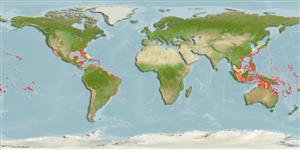Common names from other countries
Environment: milieu / climate zone / depth range / distribution range
Écologie
; profondeur 1 - 50 m (Ref. 108813). Temperate
Western Central Atlantic and Central Pacific.
Length at first maturity / Taille / Poids / Âge
Maturity: Lm ? range ? - ? cm
Description synthétique
Morphologie
Encrusting to massive growth form, usually with large lobate or digitate projections. External color is usually red or red-orange, but may also be yellow, dark green, greenish purple, or turquoise, internal color is always yellow-ochre. Texture is dense, flexible and rubbery but easy to tear, somewhat similar to cheese. Surface is generally smooth some with occasional goose-bumps. Spicules are straight sharply pointed tylostyles with large variation in size of about 300 to 700 micrometer. Some smaller ones have irregularly shaped or lumpy heads. Ectosome consists of brushes of smaller tylostyles of about 300 micrometers in size.
Combination depth range: min from literature, max from estimate. Occurs in mangrove ponds (Ref. 86789).
Life cycle and mating behavior
Maturité | Reproduction | Frai | Œufs | Fécondité | Larves
Members of the class Demospongiae are hermaphroditic. Life cycle: The zygote develops into parenchymella larva (free-swimming) before settling down on a substrate where it grows into a young sponge.
DeFelice, R.C., L.G. Eldredge and J.T. Carlton. 2001. (Ref. 3248)
Statut dans la liste rouge de l'IUCN (Ref. 130435)
statut CITES (Ref. 108899)
Not Evaluated
Not Evaluated
Menace pour l'homme
Harmless
Utilisations par l'homme
| FishSource |
Outils
Plus d'informations
Taille/ÂgeCroissanceLongueur-poidsLongueur-longueurMorphologieLarvesAbondance
Sources Internet
Estimates based on models
Preferred temperature
(Ref.
115969): 21.1 - 28.2, mean 26.5 (based on 566 cells).
